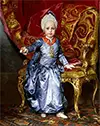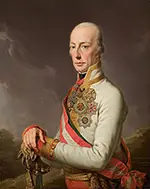Francis II: Holy Roman Emperor
Part 1: All in the Family Francis II was the last Holy Roman Emperor. His reign straddled the end of the 18th Century and the beginning of the 19th Century and was marked by the Napoleonic Wars. 
He was born on Feb. 12, 1768, in Florence, in Tuscany. His father was the eventual Holy Roman Emperor Leopold II, and his mother was Maria Luisa of Spain. The boy's uncle was the reigning Holy Roman Emperor, Joseph II, who since 1765 had served as co-ruler with his mother, Holy Roman Empress Maria Theresa. When Francis was born, his father was Duke of Tuscany, a post that he would hold for 25 years. In that capacity, Leopold introduced into Tuscany some of the ideas of the Enlightenment, a movement that emphasized reason and human rights such as basic freedoms and the pursuit of happiness. He spearheaded the creation of a political constitution for Tuscany and also, in 1786, outlawed the death penalty. In the area of public health, he championed the use of inoculation to fight smallpox, which had killed many of his extended family. By that time, Maria Theresa had died and Joseph was ruling in his own right. He had no surviving children, and so he designated his brother Leopold as his successor. As Leopold's firstborn son, Francis then took on the role of heir apparent once his father took power. As a teenager, Francis moved to Vienna, to learn the ways of the imperial court from his uncle. Francis studied politics and statecraft and also learned the ways of the military; he joined an army regiment in Hungary and was in that capacity during the 1789 seizure of Belgrade, which the Austrians retook from the Ottoman Empire during the Austro-Turkish War. Joseph II died in 1790, and Francis's father became Emperor Joseph II. The new leader traveled the empire in an attempt to restore some of the unity that had been lost in recent years. As a result, he suffered illness. Joseph died suddenly, on March 1, 1792. Francis, age 24, took the imperial throne. 
Only a month into his reign, the empire was at war with France. Francis took a personal interest in the conflict, commanding troops during the 1794 Flanders Campaign. After some initial successes, imperial troops suffered a string of defeats, eventually leading to a French occupation of Belgium. In early 1793, however, French revolutionaries killed King Louis XVI; this angered the other European monarches, and Austria suddenly had many friends. A resurgent Austria won at Aachen and Liège and then Neerwinden, forcing a French retreat straight out of Belgium. The French were back in 1794, led in one part by the famous Napoleon Bonaparte, then a young commander. France occupied the entirety of the Lowlands. More French victories took a few countries out of the war. A French victory at Loano in November 1795 gave French troops access to northern Italy. France generally had the upper hand for the next year or so, and Bonaparte led an army into Austria itself. Seeing no great armies coming from Britain or anyone else, Austria sued for peace. Under the terms of the Treaty of Campo Formio, Francis ceded Lombardy and the left bank of the Rhine. Francis again took command in the War of the Second Coalition, which began a years later. Austria had some strong successes in 1799, at Ostrach and at Stockach. The war continued along a broad front–in Italy and further north, in Germany and Switzerland. A French victory at the Battle of Marengo, on June 14, 1800, gave Bonaparte's forces control of Italy. French armies then reversed the earlier Austrian successes and on Feb. 9, 1801, the Treaty of Lunéville ended the war. One of the results of that treaty was the French acquisition of the Grand Duchy of Tuscany, where Francis was born and grew up. Next page > New Empire, Same Old Wars > Page 1, 2 |
|
Social Studies for Kids
copyright 2002–2024
David White




